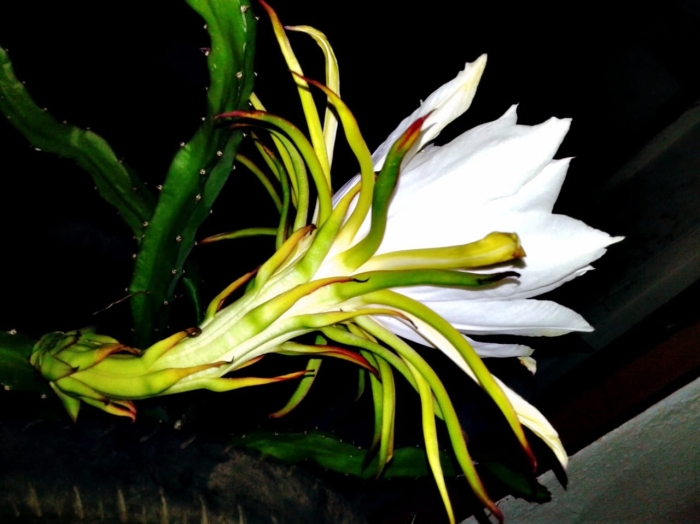White-Fleshed Pitahaya
(Selenicereus undatus)
White-Fleshed Pitahaya (Selenicereus undatus)
/
/

Sandipan Das
CC BY 4.0




















































Estimated Native Range
Summary
The dragon fruit is celebrated for its large, fragrant, nocturnal flowers, which bloom from summer to early autumn. These impressive blooms are among the largest in the cactus family, measuring up to 30 cm (11.8 in) long, and are typically greenish-yellow or whitish, occasionally with a rose tinge. Following pollination, the plant produces oblong to oval fruits, 6 to 12 cm (2.4 to 4.7 in) long, with a distinctive leathery skin covered in scales. The flesh inside is sweet and white, containing numerous small black seeds. In cultivation, Selenicereus undatus is valued for its ornamental appearance and its delicious fruit, which is high in fiber and vitamin C. It is commonly grown in tropical and subtropical gardens as an ornamental vine, often on trellises or against walls, and is also commercially cultivated for its fruit. This cactus prefers well-draining soil, high humidity, and partial to full sunlight. It requires regular watering during the growing season but should be kept drier in winter to prevent root rot. While generally pest-resistant, it can be susceptible to scale insects and mealybugs.
Gardeners should be aware that Selenicereus undatus can become invasive in some regions, so it is important to check local guidelines before planting. It is also sensitive to frost and needs protection in cooler climates.CC BY-SA 4.0
Plant Description
- Plant Type: Succulent, Vine
- Height: 5-10 feet
- Width: 5-10 feet
- Growth Rate: Rapid
- Flower Color: White
- Flowering Season: Spring, Summer
- Leaf Retention: Evergreen
Growth Requirements
- Sun: Full Sun, Part Shade
- Water: Medium, High
- Drainage: Medium, Fast
Common Uses
Bee Garden, Bird Garden, Deer Resistant, Drought Tolerant, Edible*Disclaimer: Easyscape's listed plant edibility is for informational use. Always verify the safety and proper identification of any plant before consumption., Fragrant, Hummingbird Garden, Low Maintenance, Potted Plant, Rock Garden, Showy Flowers
Natural Habitat
Native to tropical forest regions in Central America and Mexico, often growing as an epiphyte
Other Names
Common Names: Queen Of The Night, White-Fleshed Pitahaya, Nightblooming Cactus, Moonlight Cactus, Belle Of The Night, Cinderella Plant
Scientific Names: , Hylocereus undatus, Cereus undatus, Selenicereus undatus, Hylocereus undatus subsp. luteocarpus, Hylocereus tricostatus, Cereus tricostatus, Cereus undulatus, Hyalocereus undatus,
GBIF Accepted Name: Selenicereus undatus (Haw.) D.R.Hunt